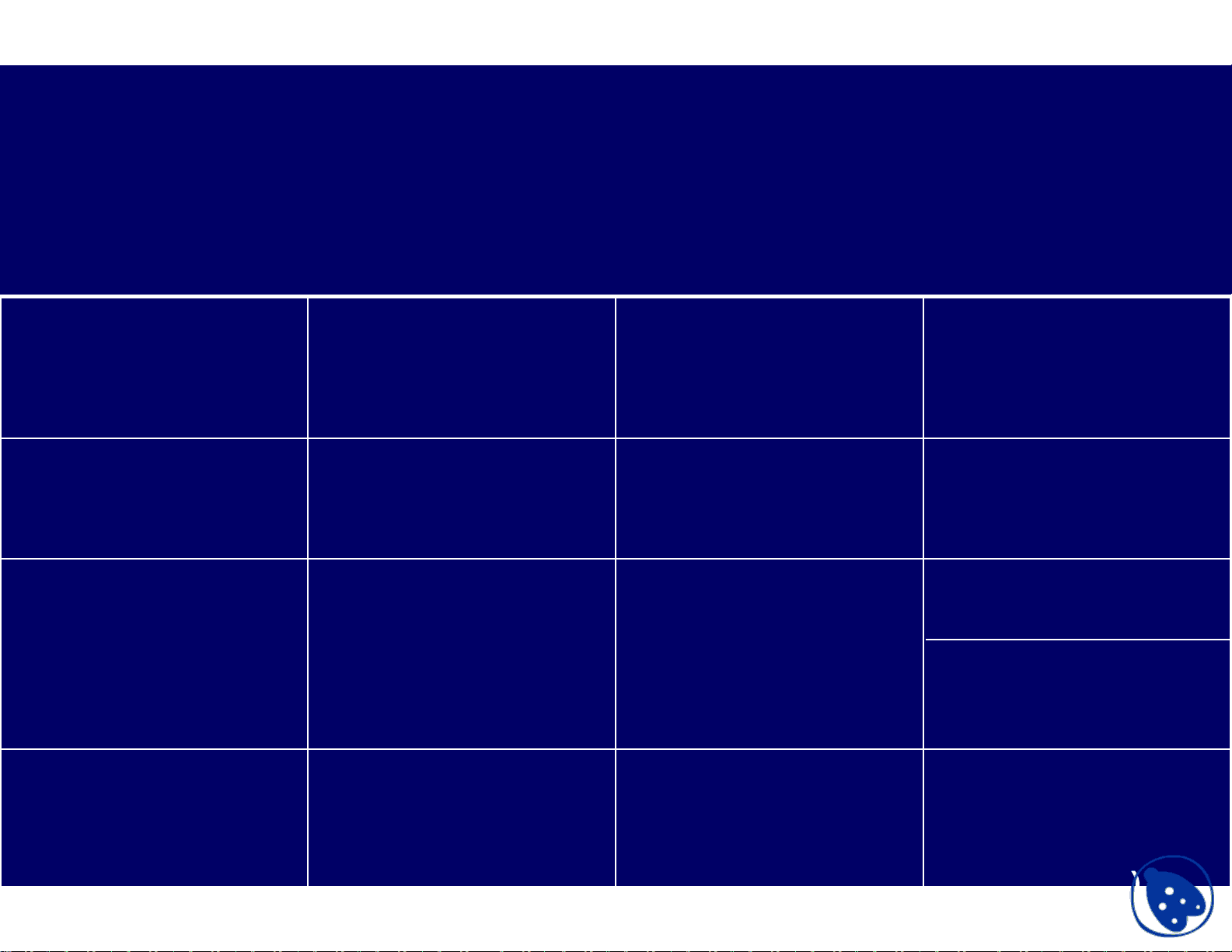
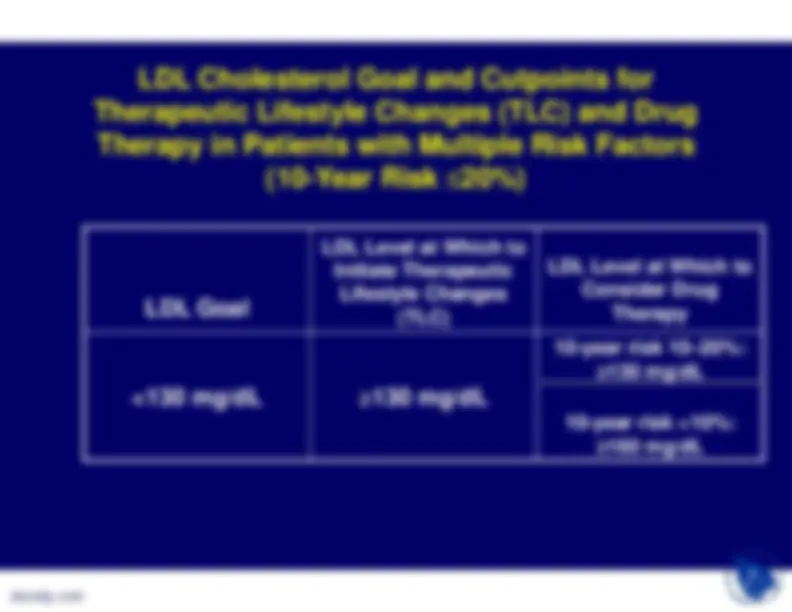
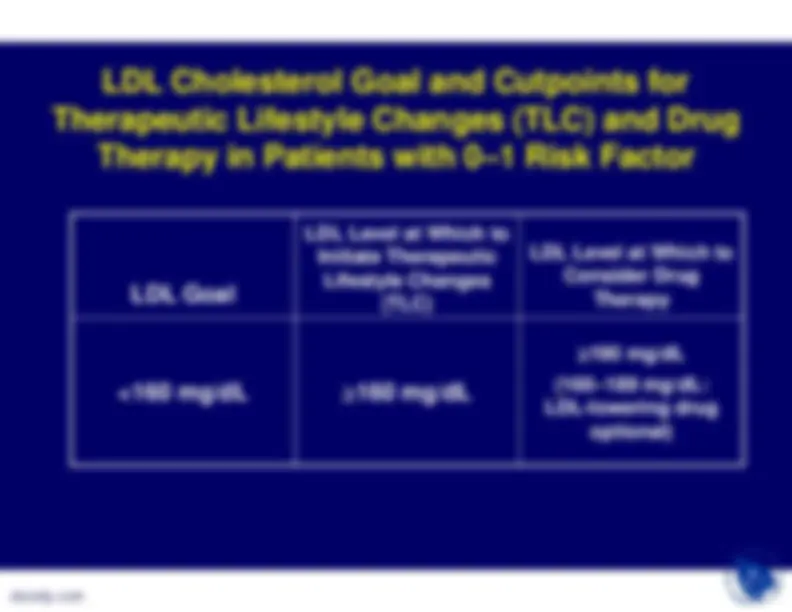
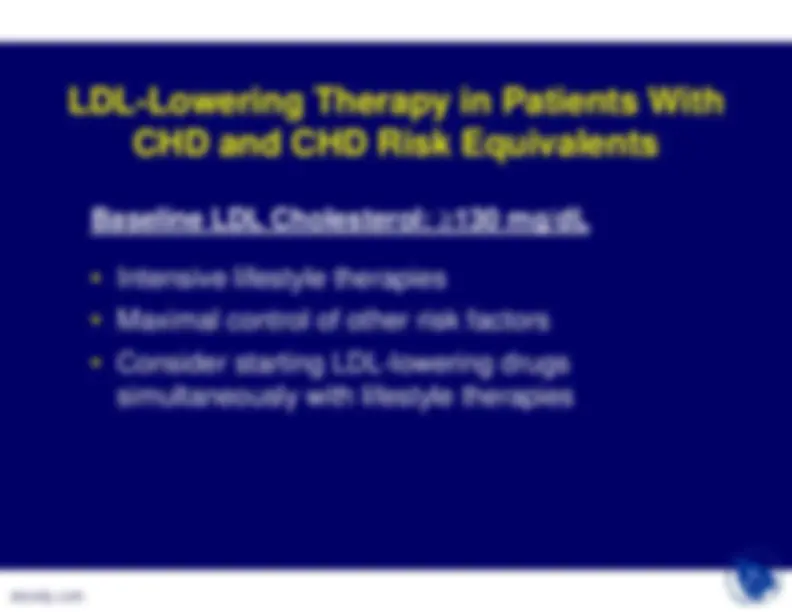
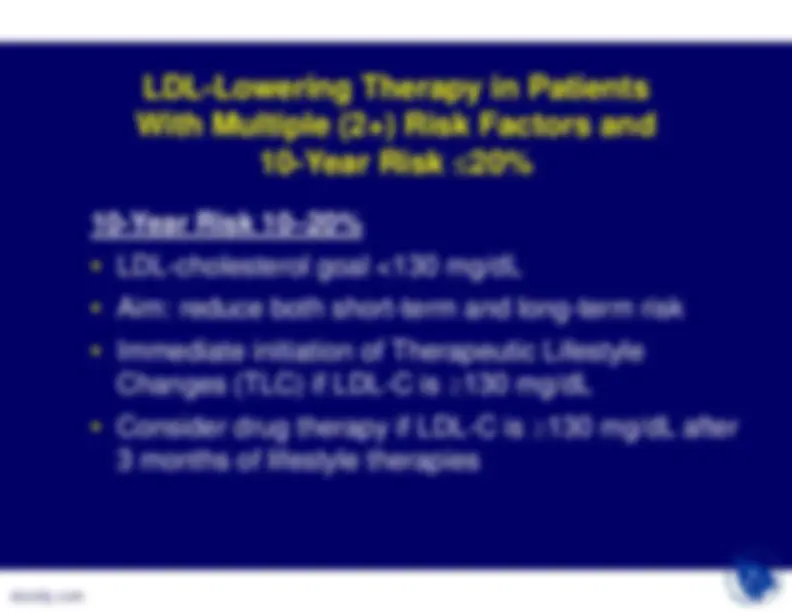
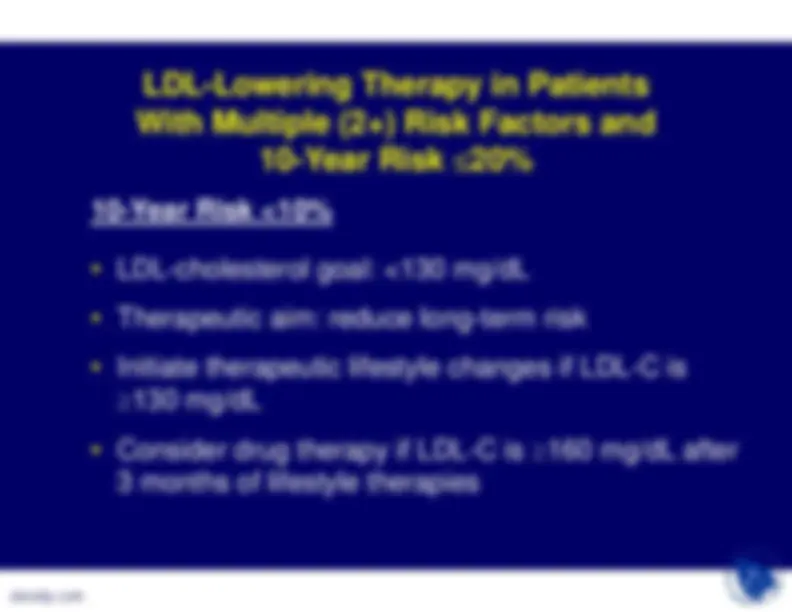
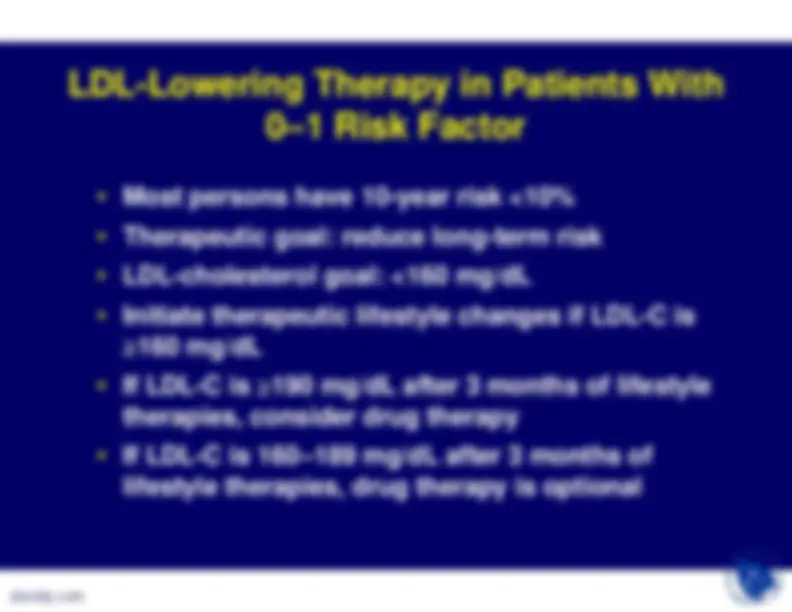

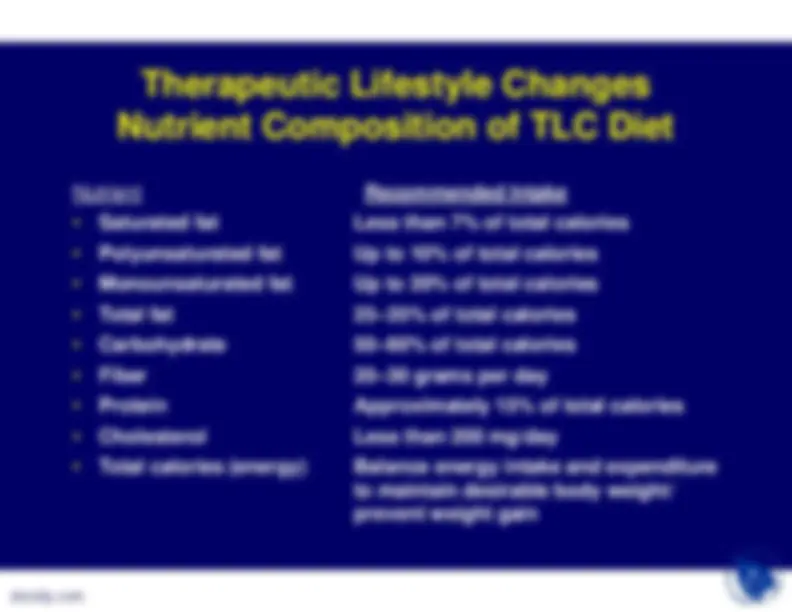
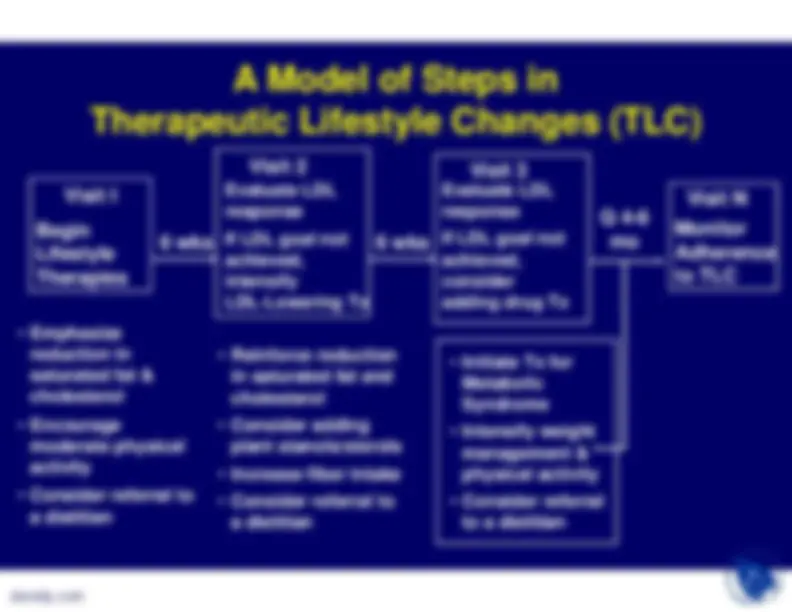
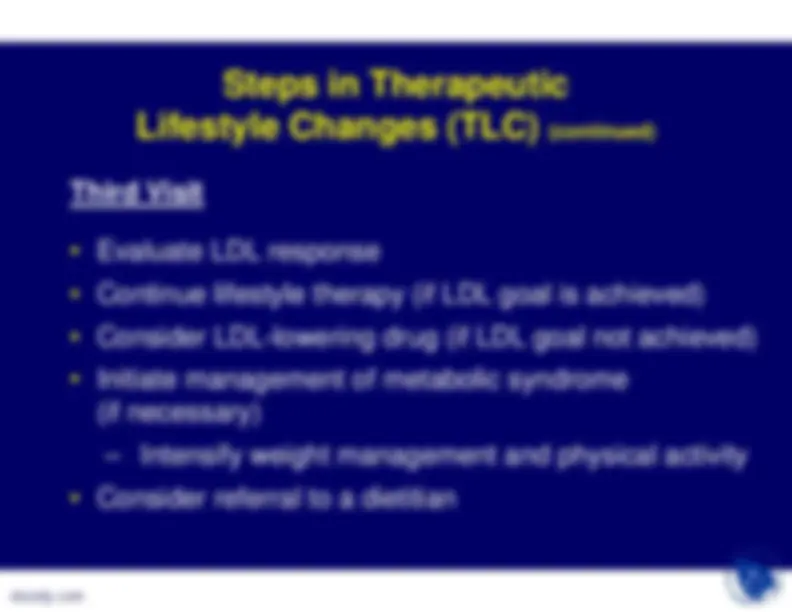
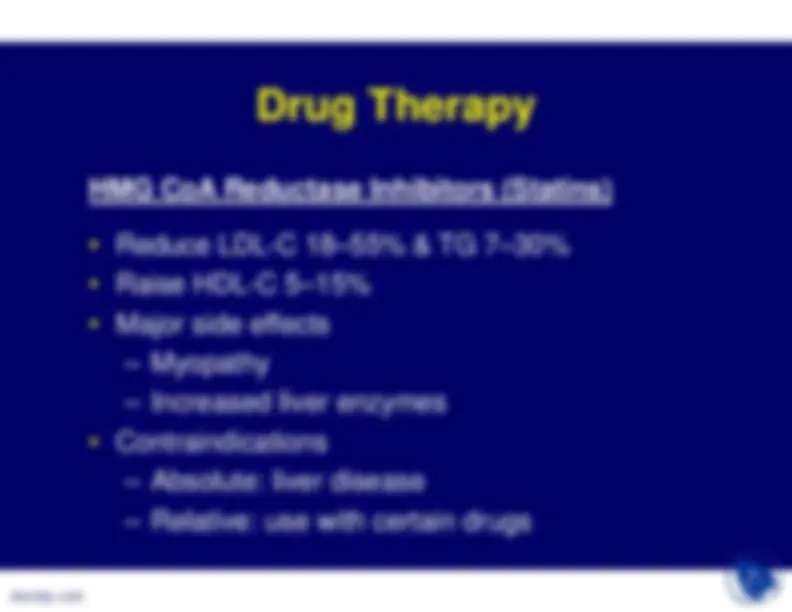
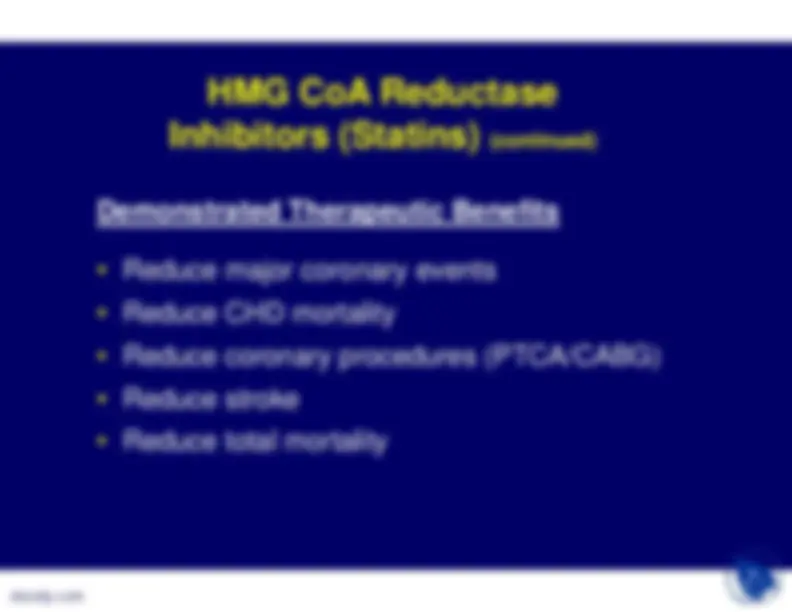
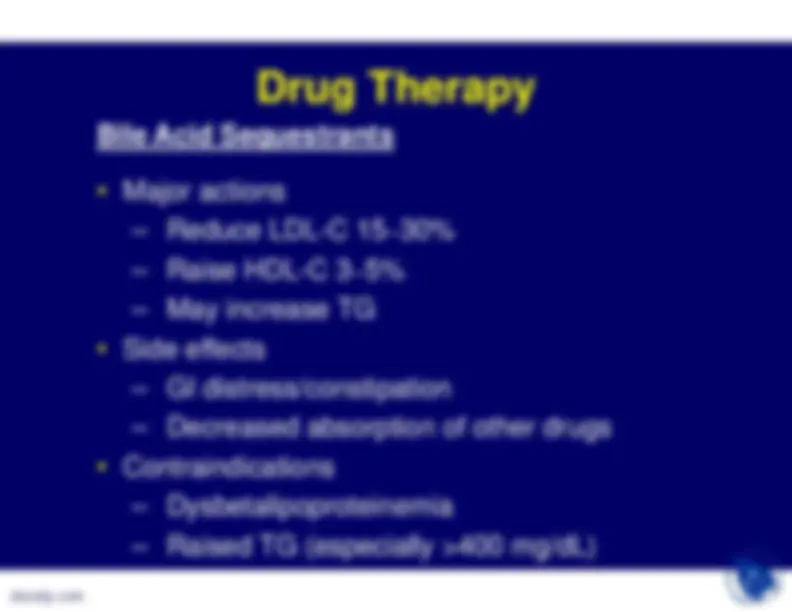
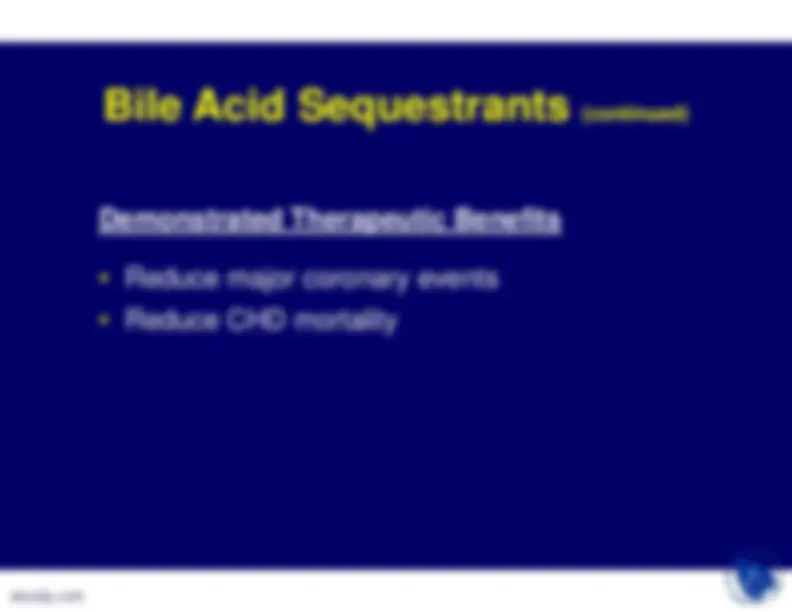
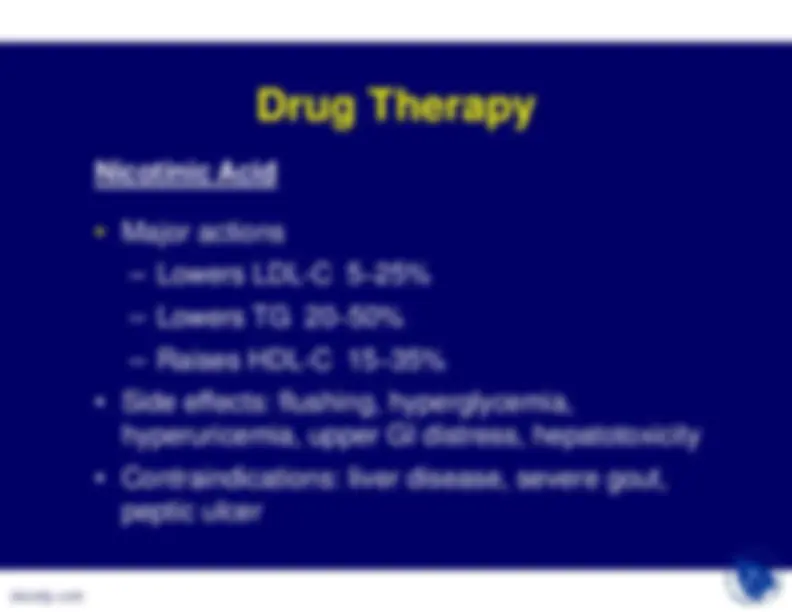
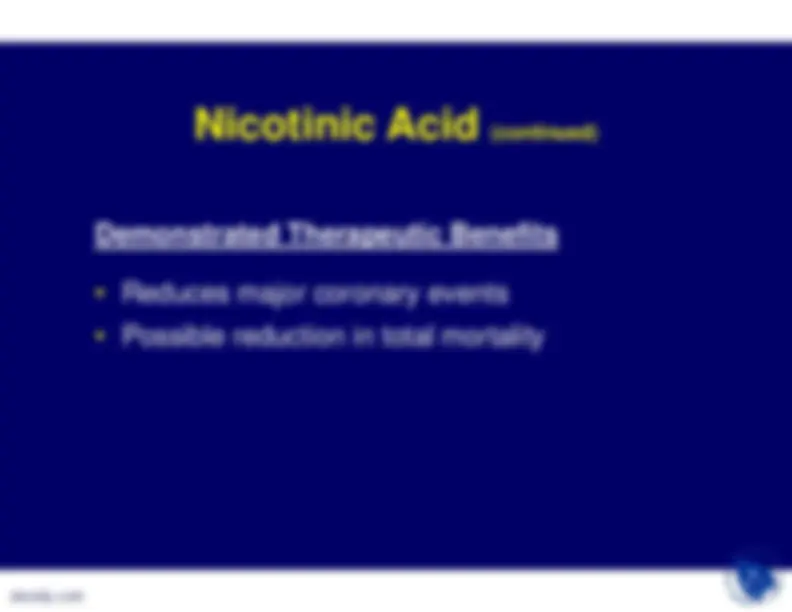
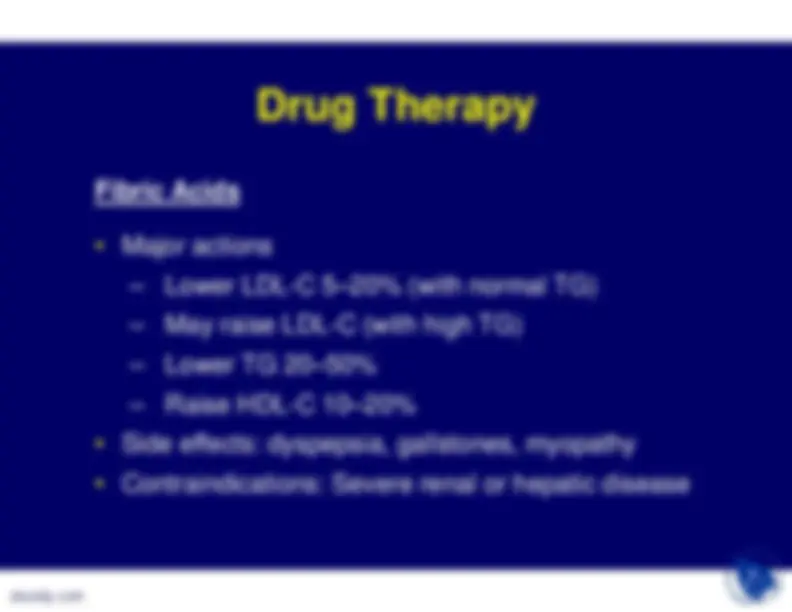
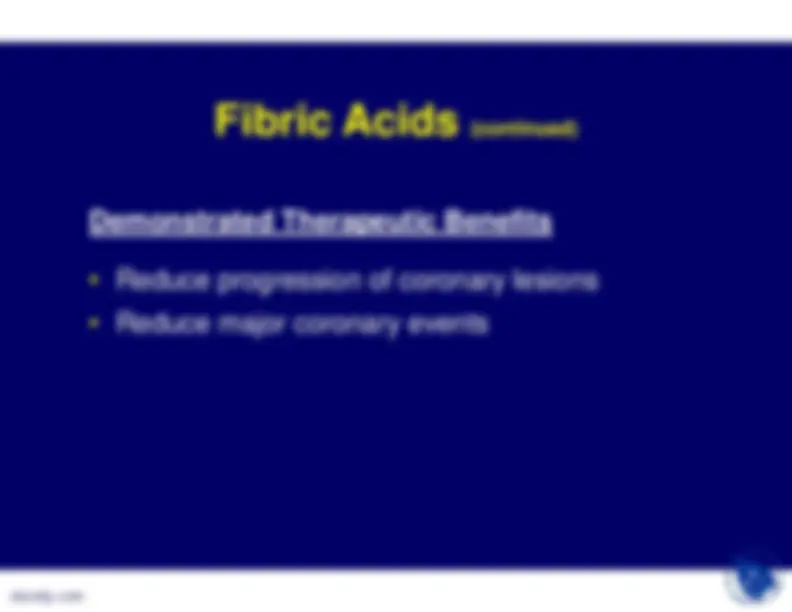
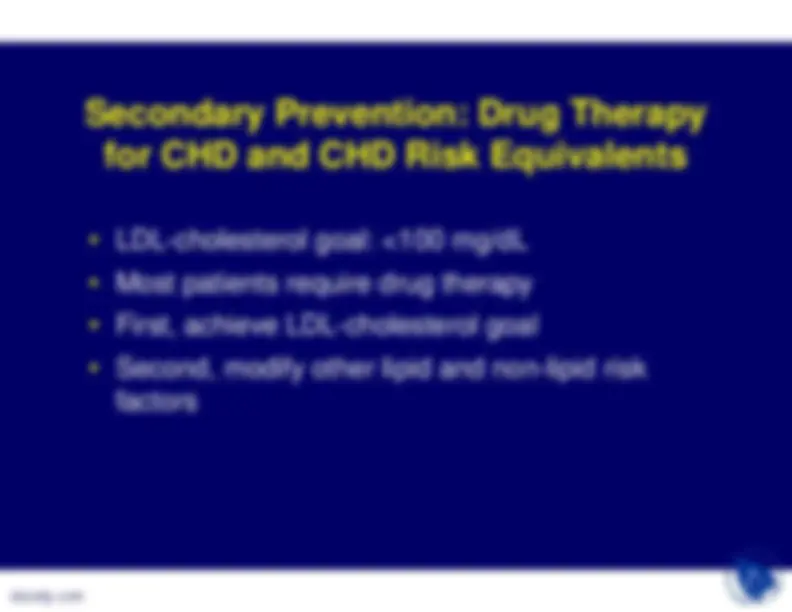
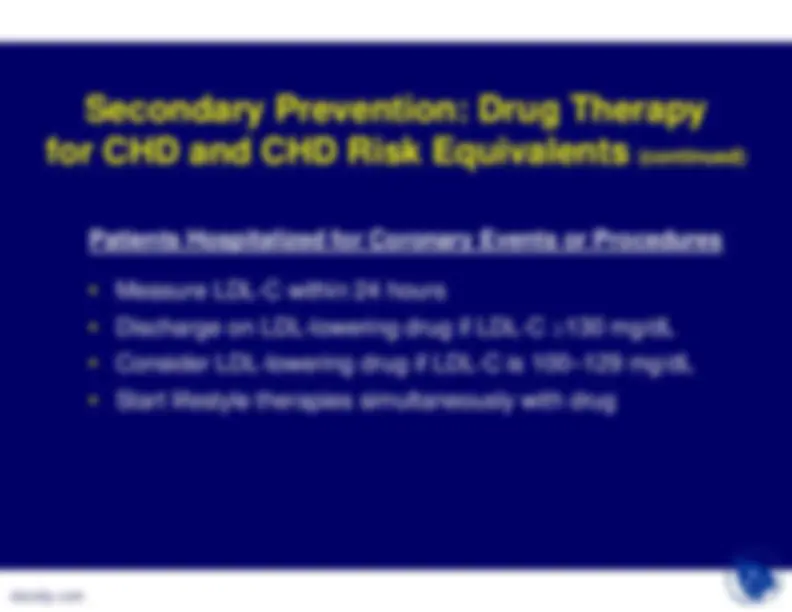
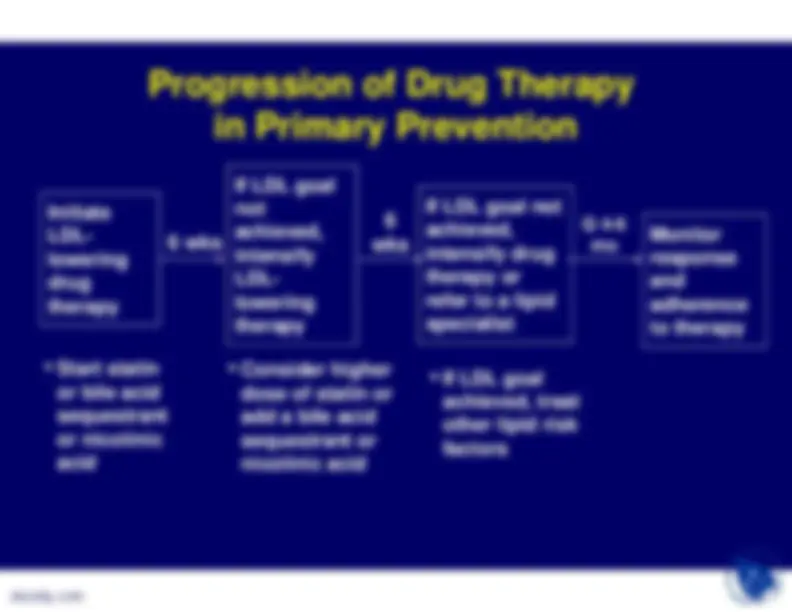

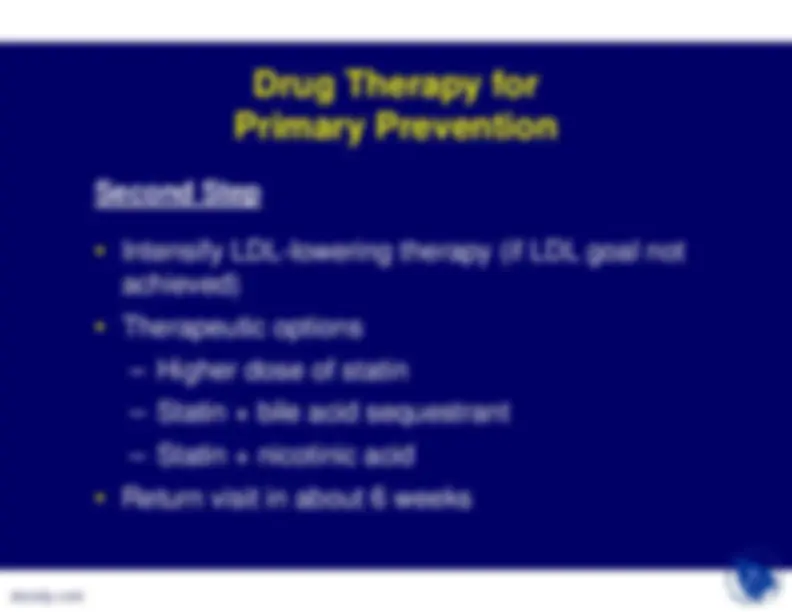
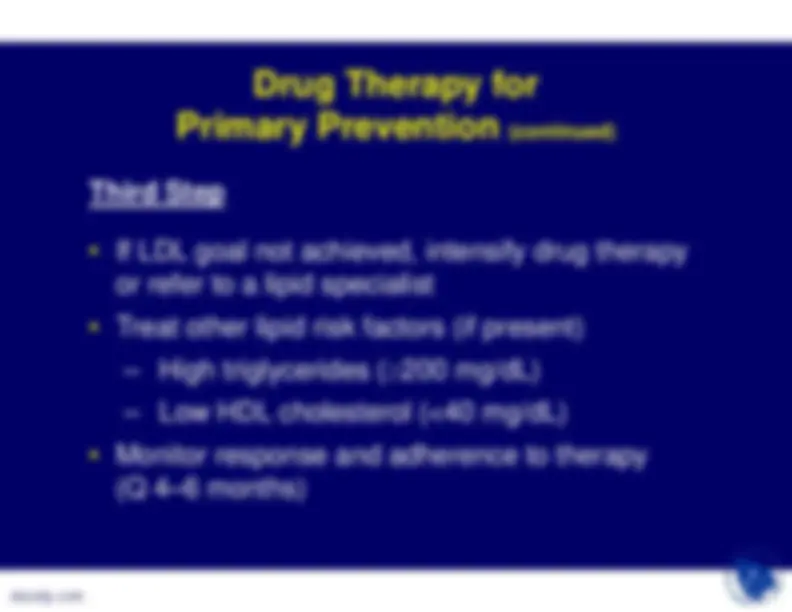


Study with the several resources on Docsity

Earn points by helping other students or get them with a premium plan


Prepare for your exams
Study with the several resources on Docsity

Earn points to download
Earn points by helping other students or get them with a premium plan
Community
Ask the community for help and clear up your study doubts
Discover the best universities in your country according to Docsity users
Free resources
Download our free guides on studying techniques, anxiety management strategies, and thesis advice from Docsity tutors
Ldl cholesterol goal and cutpoints for therapeutic lifestyle changes (tlc) and drug therapy in various risk categories, including chd or chd risk equivalents and multiple risk factors. It also discusses ldl-lowering therapy options, metabolic syndrome, and drug therapy for primary prevention.
Typology: Slides
1 / 32

This page cannot be seen from the preview
Don't miss anything!

























Risk Category
LDL Goal(mg/dL)
LDL Level at Which toInitiate Therapeutic
Lifestyle Changes
(TLC) (mg/dL)
LDL Level at Which
to ConsiderDrug Therapy
(mg/dL)
CHD or CHD Risk
Equivalents (10-year risk >20%)
<
100
^130
(100–129: drug
optional)
2+ Risk Factors (10-year risk
20%)
<
130
10-year risk 10–
20%:
130
10-year risk <10%:
^160
0–1 Risk Factor
<
160
^190
(160–189: LDL-lowering drug
optional)
docsity.com
LDL Cholesterol Goal and Cutpoints for
Therapeutic Lifestyle Changes (TLC) and Drug
Therapy in Patients with CHD and CHDRisk Equivalents (10-Year Risk >20%)
130 mg/dL
(100–129 mg/dL:
drug optional)
100 mg/dL
<100 mg/dL
LDL Level at Which toConsider Drug Therapy
LDL Level at Which to
Initiate Therapeutic Lifestyle Changes (TLC)
LDL Goal
190 mg/dL (160–189 mg/dL:LDL-lowering drug
optional)
160 mg/dL
<160 mg/dL
LDL Level at Which to
Consider Drug
Therapy
LDL Level at Which to Initiate TherapeuticLifestyle Changes
(TLC)
LDL Goal
LDL-Lowering Therapy in Patients With
CHD and CHD Risk Equivalents
Baseline LDL Cholesterol:
130 mg/dL
Intensive lifestyle therapies
-^
Maximal control of other risk factors
-^
Consider starting LDL-lowering drugssimultaneously with lifestyle therapies
LDL-Lowering Therapy in Patients With
CHD and CHD Risk Equivalents Baseline LDL-C: <100 mg/dL •^
Further LDL lowering not required
-^
Therapeutic Lifestyle Changes (TLC) recommended
-^
Consider treatment of other lipid risk factors–
Elevated triglycerides
Low HDL cholesterol
Ongoing clinical trials are assessing benefit offurther LDL lowering
10-Year Risk 10–20% •^
LDL-cholesterol goal <130 mg/dL
-^
Aim: reduce both short-term and long-term risk
-^
Immediate initiation of Therapeutic LifestyleChanges (TLC) if LDL-C is
130 mg/dL
Consider drug therapy if LDL-C is
130 mg/dL after
3 months of lifestyle therapies
LDL-Lowering Therapy in Patients With
0–1 Risk Factor
-^
Most persons have 10-year risk <10%
-^
Therapeutic goal: reduce long-term risk
-^
LDL-cholesterol goal: <160 mg/dL
-^
Initiate therapeutic lifestyle changes if LDL-C is
160 mg/dL
-^
If LDL-C is
190 mg/dL after 3 months of lifestyle
therapies, consider drug therapy
-^
If LDL-C is 160–189 mg/dL after 3 months oflifestyle therapies, drug therapy is optional
Factors Favoring Drug Therapy •^
Severe single risk factor
-^
Multiple life-habit risk factors and emerging riskfactors (if measured)
Therapeutic Lifestyle Changes in
LDL-Lowering Therapy
Major Features •^
TLC Diet–
Reduced intake of cholesterol-raising nutrients (same asprevious Step II Diet)^
Saturated fats <7% of total calories ^
Dietary cholesterol <200 mg per day
LDL-lowering therapeutic options^
Plant stanols/sterols (2 g per day) ^
Viscous (soluble) fiber (10–25 g per day)
-^
Weight reduction
-^
Increased physical activity
Therapeutic Lifestyle Changes Nutrient Composition of TLC Diet
Nutrient
Recommended Intake
-^
Saturated fat
Less than 7% of total calories
-^
Polyunsaturated fat
Up to 10% of total calories
-^
Monounsaturated fat
Up to 20% of total calories
-^
Total fat
25–35% of total calories
-^
Carbohydrate
50–60% of total calories
-^
Fiber
20–30 grams per day
-^
Protein
Approximately 15% of total calories
-^
Cholesterol
Less than 200 mg/day
-^
Total calories (energy)
Balance energy intake and expenditureto maintain desirable body weight/prevent weight gain
Steps in Therapeutic
Lifestyle Changes (TLC)
First Visit •^
Begin Therapeutic Lifestyle Changes
-^
Emphasize reduction in saturated fats andcholesterol
-^
Initiate moderate physical activity
-^
Consider referral to a dietitian (medical nutritiontherapy)
-^
Return visit in about 6 weeks
Steps in Therapeutic
Lifestyle Changes (TLC)
(continued)
Second Visit •^
Evaluate LDL response
-^
Intensify LDL-lowering therapy (if goal not achieved)–
Reinforce reduction in saturated fat and cholesterol
Consider plant stanols/sterols
Increase viscous (soluble) fiber
Consider referral for medical nutrition therapy
-^
Return visit in about 6 weeks
HMG CoA Reductase Inhibitors (Statins) •^
Reduce LDL-C 18–55% & TG 7–30%
-^
Raise HDL-C 5–15%
-^
Major side effects– Myopathy– Increased liver enzymes
-^
Contraindications– Absolute: liver disease– Relative: use with certain drugs
HMG CoA Reductase
Inhibitors (Statins)
(continued)
Demonstrated Therapeutic Benefits •^
Reduce major coronary events
-^
Reduce CHD mortality
-^
Reduce coronary procedures (PTCA/CABG)
-^
Reduce stroke
-^
Reduce total mortality